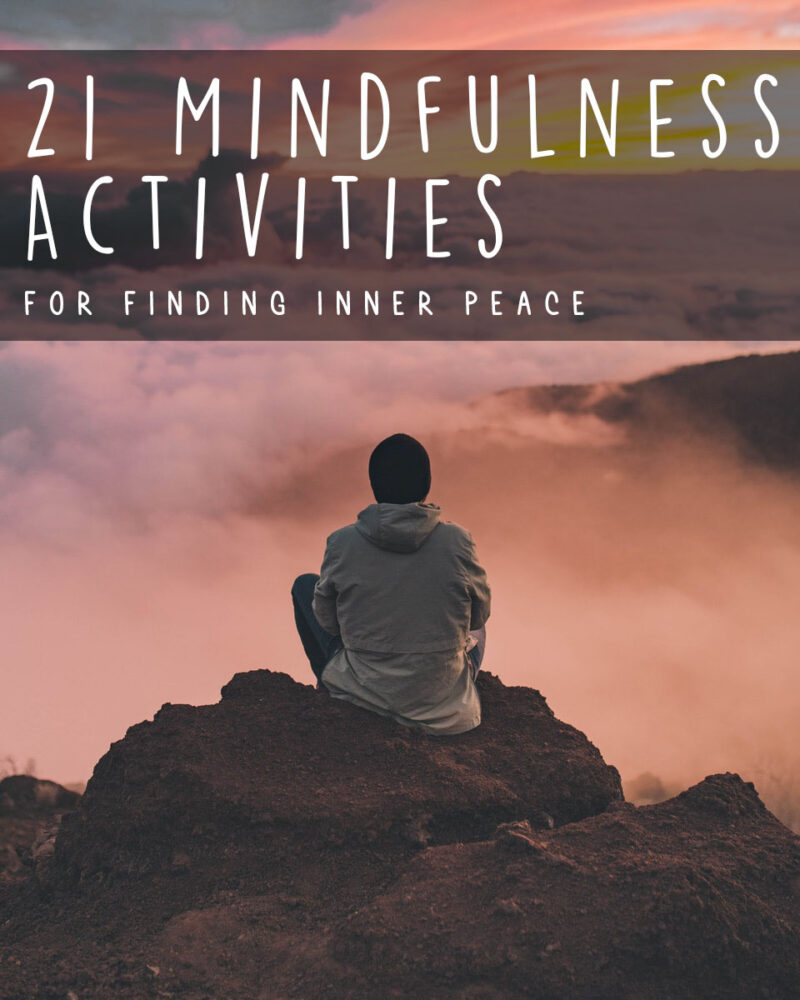As you’re probably already aware, mindfulness is all about living in the moment and engaging with your surroundings. Sounds simple, right? Well, yes and no. While everyone has the potential to be mindful, there are various tried-and-tested mindfulness activities out there that could improve your technique.
By learning how to embrace the art of mindfulness, you will improve your health and overall quality of life. Did you know, for example, that meditation can reduce the symptoms of pre-menstrual syndrome (PMS) by 57%? Or that meditating lowers the severity of insomnia in 75% of cases? If you’re ready to improve your physical and mental wellness, we’ve put together a comprehensive guide to mindfulness activities below.
Remember to bookmark this page and refer back to it whenever you want to try a new mindfulness activity. Your body and brain will thank you for it!
How to use this guide
To help you get to grips with mindfulness and find mindfulness activities that work for you, we’ve split this guide into two parts. The first part will explore formal mindfulness, which encompasses a range of meditative mindfulness activities. We’ve included step-by-step instructions to make the processes as simple as possible, as well as difficulty ratings to help guide you on your mindfulness journey! If you’ve tried meditation before, you may wish to skip over the introductory exercises.
The second part of the guide explores informal mindfulness meditation. This type of mindfulness is much broader and includes an almost endless range of activities. The purpose of informal mindfulness is to bring awareness and calm to your everyday life. We encourage readers to try out their own informal mindfulness activities and have featured some of our favorites in this guide to spark inspiration!
Table of contents
- How to use this guide
- Formal mindfulness activities: Getting started with meditation
- Exercise #1: Practicing mindfulness with food
- Exercise #2: The body scan
- Exercise #3: Relaxing breathing exercise
- Exercise #4: Visualization meditation
- Exercise #5: Walking meditation
- Exercise #6: Transcendental meditation
- Exercise #7: Diaphragmatic breathing meditation
- Exercise #8: Focused meditation
- Exercise #9: Questioning your beliefs about your life
- Exercise #10: Naming meditation
- Informal mindfulness activities: Incorporating exercises into your everyday life
- Exercise #1: Be mindful while you’re waiting for something
- Exercise #2: Turn off your devices
- Exercise #3: Sit and listen to music
- Exercise #4: Have a bath
- Exercise #5: Bring mindfulness to your social interactions
- Exercise #6: Do nothing
- Exercise #7: Bake some cookies
- Exercise #8: Fill an adult coloring book
- Exercise #9: Knit a scarf
- Exercise #10: Drive mindfully
- Exercise #11: Write in your journal
- The bottom line: It’s never a bad time to practice these mindfulness activities
Formal mindfulness activities: Getting started with meditation
So, you’ve decided to allow mindfulness into your life and learn how to meditate – congratulations! You’ve made the first important step toward a calmer and more fulfilling future. The following exercises will help you become a meditation pro, no matter your age or background. We recommend starting from the beginning and working your way up, but feel free to pick and choose specific mindfulness activities if you’re already familiar with meditation.
Exercise #1: Practicing mindfulness with food
Difficulty rating: 1/5
You can try this exercise with any food of your choice. While it may feel a little silly or unnatural at first, it will help you understand the basics of mindfulness in a few simple steps! Here’s how to do it:
- Sit in a quiet place where you feel comfortable, with your food placed in front of you. You can sit in the lotus position (cross-legged) or on a chair with your feet touching the floor.
- Focus your attention on the piece of food. How does it look and feel? Does it change shape when you touch it? Does it have a strong or subtle smell? What does it taste like? Try to channel all your attention toward the sensory experiences of your chosen food.
- Spend at least two or three minutes on this task. If your mind starts to wander, guide it back toward the task at hand.
- Voila! Your first attempt at mindfulness is complete.
If you follow these instructions closely, you should learn how to live more attentively in the moment and cast worries aside. By practicing this technique every day or so, you should start to get used to meditating.
Exercise #2: The body scan
Difficulty rating: 2/5
The body scan is one of the most effective mindfulness activities out there. And it is perhaps one of the most common beginner exercises for meditation rookies. A well as requiring very few tools, it’s quick and easy to follow. Here are the steps:
- Start by lying on your back with your feet resting slightly to the side. You can lie anywhere for this exercise, but we recommended lying on a firm yoga mat. If you’re unable to lie down, you can also sit on a chair with your feet touching the floor.
- Focus on your breathing. Notice the rhythm of every breath and try to breathe in through your nose and out through your mouth.
- Think about how your body feels. Are your clothes soft or scratchy? Which parts of your body are touching the floor? Are you feeling cold or warm?
- Move your attention to individual parts of the body, starting with the feet and working your way up to your head. As you do this, try to release any tension in each body part. You may wish to tense and relax your muscles for maximum effect.
- Once you’ve accounted for every body part, slowly open your eyes, and sit up. You may need to take a few minutes to adjust to your surroundings, as you’ll probably feel very relaxed!
This exercise is perfect for people hoping to reconnect with their bodies. Try it first thing in the morning to help you weather a stressful day, or just before bed to banish sleeplessness.
Exercise #3: Relaxing breathing exercise
Difficulty level: 2/5
This exercise is super simple and will help to calm your nervous system. Try not to hold your breath for too long if you start feeling dizzy – this activity isn’t designed to make you feel unwell! Here are the steps you need to get it right:
- Sit in the lotus position or on a chair, ensuring your back is as straight as is comfortable.
- Place the tip of your tongue on the roof of your mouth, just in front of your front teeth. Try and keep it in place throughout the exercise.
- Inhale through your nose, counting slowly to four.
- Once you reach four, hold your breath for around seven seconds (more, if possible, and less if you start feeling dizzy).
- Exhale slowly through your mouth for around eight seconds.
- Repeat three or four times.
While this technique may seem a little basic, it could work wonders for your stress levels and help you refocus your mind.
Exercise #4: Visualization meditation
Difficulty level: 3/5
This exercise requires nothing more than your imagination and a few spare minutes. If you’re a chronic daydreamer, practicing visualization meditation will help you to focus your thoughts and use your active mind to live in the moment. It’s a little trickier than the exercises above, as you’ll need to use your imagination to its full potential. Here’s how:
- Sit somewhere comfortable and close your eyes. Imagine you’re in a relaxing setting such as a beach, a leafy park, or a tranquil cabin in the woods.
- Use your imagination to gain a feel for your new surroundings. What’s the temperature like? Is the weather balmy and hot or calmingly rainy? Do you hear any birds or buzzing insects? Perhaps you can smell the salt of the ocean or a burning candle?
- If you have any intrusive or stressful thoughts during this process, gently acknowledge them and brush them away.
- Open your eyes whenever you feel ready.
After some practice, you should be able to meditate in this way for ten minutes (or longer) without experiencing any intrusive thoughts. Just remember to transport yourself to somewhere you’d genuinely like to spend time!
Exercise #5: Walking meditation
Difficulty level: 2/5
Some of the most effective mindfulness activities are those that you can do as part of your normal routine. A walking exercise is great for those who have trouble sitting still. It’s also a great way to reconnect with nature if you live near a park or natural beauty spot. Steps include:
- Find a tranquil outdoor spot free from other people.
- Take 15 steps, pause, and breathe deeply for as long as desired.
- Closely observe your surroundings, contemplating the beauty of the trees and flowers. No detail is too small – absorb everything from the drops of dew on the grass to the shape of the bark on the trees.
- Take another 15 steps, observing sensory experiences such as the crunch of leaves under your feet to the cool breeze on your face.
- If your mind wanders at any point, try to brush aside intrusive thoughts, and focus on your immediate environment.
After practicing walking meditation for a few weeks, you’ll start to find sedentary exercises much easier.
Exercise #6: Transcendental meditation
Difficulty level: 4/5
Transcendental meditation (TM) is favored by many celebrities and mindfulness pros. As well as lowering stress levels and improving sleep, recent studies show that TM could significantly reduce the symptoms of post-traumatic stress disorder (PTSD). You’ll need a high level of focus to enjoy the full benefits of TM, so it may be worth building your meditation skills up before attempting a session. Here’s how to do it:
- Find a spare 20 minutes in your day and prepare your meditation space. Your TM session may be a little longer than you’re accustomed to, so remember to put your phone on silent and tell your friends and family members not to disturb you. You may also wish to burn incense or light some sweet-smelling candles.
- Sit in a chair or cross-legged on the floor, placing your hands on your lap.
- Close your eyes and relax your muscles. Try not to open your eyes for the remainder of the exercise.
- Silently repeat a mantra in your head. While some people choose Sanskrit words, feel free to user any phrases that resonate with you.
- Give your undivided attention to the mantra. If your mind starts to wander, remember to guide it back to your chosen mantra. You should try to maintain this focus for at least 20 minutes, setting an alarm for yourself if necessary.
- Once your meditation is complete, slowly open your eyes and sit silently until you feel ready to resume your day.
Exercise #7: Diaphragmatic breathing meditation
Difficulty level: 3/5
This exercise is great for people with strong physical stress responses, helping to calm the nerves and ease panicky symptoms. It’s not particularly difficult to follow but will require commitment and a space for you to lie down. The instructions are as follows:
- Lie on your back on a comfortable surface, with a pillow supporting your head. You can also place a pillow under your knees if desired.
- Place one hand below your ribcage and the other on your chest, breathing in deeply through your nose. You should focus on the movements of your stomach as you breathe, allowing your diaphragm to expand to full capacity.
- Allor your stomach muscles to tense up as you exhale through your mouth.
- Repeat these motions for around 10 minutes.
You’ll notice yourself feeling much calmer after a single session of diaphragmatic breathing. If you’re going through a stressful patch, don’t hesitate to repeat the exercise as often as you’re able.
Exercise #8: Focused meditation
Difficulty: 4/5
Do you struggle to stay focused on work? Perhaps your mind wanders during conversations with friends? Practicing focused meditation could help to sharpen your concentration (and avoid awkward social situations!). Some mindfulness activities take a bit of practice, and the willingness to dedicate small bits of time in order to maximize the impact. It may take a while to hone this technique, particularly if you’re a bit of a daydreamer, but it’ll pay off in the long run. Here’s how to do it:
- Choose an object on which to focus your attention. It can be anything, from a piece of fruit to your favorite lipstick.
- Close your eyes and focus on the rhythm of your breath, inhaling and exhaling deeply and slowly.
- Open your eyes and examine the object, considering all its tiny details.
- Close your eyes again and picture the object in your mind. Try to recall as many minor details as possible, from little scratches to individual colors.
- After 10 minutes or so, open your eyes and look at the object again. How accurate was your mental picture?
After a few sessions of focused meditation, you’ll start to become more perceptive and focused in your everyday life.
Exercise #9: Questioning your beliefs about your life
Difficulty level: 5/5
Many of us have a set of stories we tell ourselves about our lives and personalities. Often, these stories can limit our capacity to make changes to our lives and connect with new people. This form of meditation will teach you to let go of harmful narratives and reconfigure your approach to the world. It may feel uncomfortable and tricky at first, so don’t try this exercise until you’re accustomed to meditation. Here’s how to get started:
- Find a tranquil place where you won’t be disturbed by friends or family members.
- Close your eyes and sit in a comfortable position.
- Ask yourself what narratives you believe about yourself and how they may be stopping you from pursuing certain goals.
- Consider what you really want out of life, rather than following narratives put forward by your family or wider society.
- Once you’ve found a narrative you’d like to change, focus on how your body feels when you think about it.
- What thoughts emerge when you believe harmful narratives?
- Next, think about who or what created the story.
- Start to consider how you’d feel if you didn’t believe in the story. Feel your body let go and release any tension.
- Consider what you’d do differently if this narrative didn’t exist.
- Sit with your thoughts and focus on your breathing for a few minutes. When you’re ready, open your eyes and go about your day.
Exercise #10: Naming meditation
Difficulty level: 2/5
Finally, this meditation exercise is a great one for busy remote workers who struggle to start the day with a focused mind. So, grab a warming cup of coffee and learn to love your mornings again with the following steps:
- Sit down somewhere comfortably, with your feet touching the floor.
- Look around your room and name three things you can hear. If it’s quiet, you’ll need to listen really carefully. Perhaps you can hear the sound of distant traffic or the wind rustling through the trees? Focus on the names of these sounds for a few minutes, remembering to guide your mind back to the task at hand whenever necessary.
- Name two things you can see. Again, focus on these words for a few minutes, breathing deeply as you do so.
- Name one sensation you can feel. This may be a little trickier, but it will help you feel connected to your surroundings. Perhaps you feel cold, jittery, comforted, or cocooned? Try to think outside the box and sit with your thoughts for a few moments before commencing your day!
This exercise is perfect for people looking for a quick mindfulness exercise they can do every morning without disrupting their routine. But what about activities that don’t strictly fall into the category of meditation? Well, we explore a few more exciting mindfulness activities below. Keep reading!
Informal mindfulness activities: Incorporating exercises into your everyday life
As you can see, there are tons of ways to try meditation – and the exercises listed above are just the tip of the iceberg. Mindfulness is a way of life, and there are plenty of ways you can apply what you’ve learned during meditation to real-world situations. Here are just a few ideas to get you started:
Exercise #1: Be mindful while you’re waiting for something
What’s the first thing you do while waiting in a queue? Most of us immediately turn to our phones to fill the time. While scrolling Twitter or checking in with friends may feel like a good use of your time, it could increase your anxiety, particularly if you have access to work emails on your phone. So, why not leave your phone in your pocket and use the time for a spot of mindfulness?
Try to absorb all the minor details of your surroundings. What can you hear, smell, or feel? Remember to breathe deeply and dismiss any intrusive thoughts that distract you from your activity. You never know – you may discover something beautiful in a simple queue at the post office.
Exercise #2: Turn off your devices
Phone addicts, listen up: turning off your digital devices (even for a short while) could significantly improve your mental health and cognitive abilities. While phones and tablets are super useful for everything from communicating with friends to checking your bank balance, they can also affect your ability to feel calm and focused. The constant disruption of notifications – and even the temptation of exploring the internet – can affect your ability to concentrate on tasks. If you’re naturally anxious, having a phone by your side may also increase your stress levels. We all know how agonizing it can feel to wait for someone to text back.
The solution? Turn off all your devices and take a moment to relax. Sit with your thoughts and focus on something you enjoy, such as baking or reading. Even half an hour of screen-free time could improve your mood and reduce stress. You may feel a little strange at first – we’re so accustomed to checking our phones every few minutes that denying yourself access to a screen can be anxiety-inducing. Don’t fret – this is perfectly normal and will disappear over time. Trust us – you’ll thank yourself in the long run!
Exercise #3: Sit and listen to music
Many of us listen to music to make boring or repetitive tasks more entertaining. From jogging to cleaning, hitting play on the latest tunes can be one of life’s greatest pleasures. But is this way of listening to music the best way to use your Spotify account? If you’re using music to distract yourself from another task, you can’t give it your full attention. You may notice the beauty of the lyrics or examine how the songs make you feel.
To improve your relationship with music and become more mindful, why not spend a few minutes a day concentrating on a song or two? Committing yourself to the task could hone your perceptive abilities and make you more focused.
Exercise #4: Have a bath
Taking a long, hot bath will help you to unwind after a long day. Start by drawing yourself the bubbliest, most inviting bath you can master. Hey, you could even light a few candles or burn some incense if you’re feeling fancy!
Once you’re in the tub, close your eyes and try to empty your mind of any worries. Focus on the feel and smell of the bubble bath and remember to breathe deeply. After twenty minutes or so, you’ll start to feel deliciously calm and relaxed. This activity is particularly helpful for insomniacs, so switch your daily shower for a late-night bath if you’re struggling to nod off.
Exercise #5: Bring mindfulness to your social interactions

So many of us are chronically distracted nowadays that we forget to listen to our friends. Sure, you may be able to follow your conversations on a basic level, but are you really listening to what they’re saying? How are they feeling, and how could you offer genuinely supportive feedback?
Many people focus too heavily on how to respond to their friends before they even finish talking. Avoid this planning approach and give your full attention to conversations.
Exercise #6: Do nothing
Bored? Listless? Feel like you’ve watched every film and read every book worth reading? Many people are constantly on the lookout for activities with which to occupy themselves. If this sounds like you, allow us to let you in on a little secret: it’s okay to do nothing from time to time.
In a world obsessed with productivity, staring at the ceiling for fifteen minutes can feel pointless – sinful, even. Nothing could be further from the truth. Taking a few minutes to do nothing at all is a great way to get lost in your thoughts and process difficult feelings. Freed from distraction, you may have exciting revelations or creative breakthroughs that could transform your life. Don’t be shy – give it a go today!
Exercise #7: Bake some cookies
Baking is a soothing task that will help to clear your mind and fill your fridge with sweet treats! Following a recipe gives you something to focus on and helps to banish negative thoughts. The sensory experiences that come with baking also present plenty of opportunities to get mindful. Try to focus on the delicious smell of your dough as it cooks, breathing in deeply and slowly.
Exercise #8: Fill an adult coloring book
Adult coloring books are all the rage among practitioners of mindfulness. Why? Well, it has nothing to do with reliving one’s childhood. Rather, the repetitive actions of coloring can help focus the mind and calm any nerves. Fortunately, you won’t need to borrow your four-year-old’s coloring book to do this exercise, as there are plenty of adult versions on the market. Just remember to stay within the lines!
Exercise #9: Knit a scarf
Knitting is another activity that requires repetitive motions and extreme focus. What’s more, it’s less difficult than you might expect. There are plenty of excellent knitting guides available online if you’re a total beginner. Alternatively, why not invest in a knitting book or join a casual class? Once you’ve got the hang of it, you’ll realize that sitting down and knitting a scarf is a uniquely meditative activity. Just remember to pour all of your concentration into the task at hand and brush away intrusive thoughts as you knit.
Exercise #10: Drive mindfully
Are you prone to stress while driving? Perhaps you’re often distracted by the beep of your phone? Mindful driving will help you to stay focused on the task of driving and improve your abilities on the road. To drive mindfully, focus on the sensation of driving. Think about the weight of your car, the texture of the road, the sound of wheels, and the shape of your seat. When you’re fully in the moment, you can focus on your environment more closely, improving your awareness of pedestrians, traffic lights, and other vehicles. Just remember to turn off your music and keep your phone on silent.
Exercise #11: Write in your journal
Journaling has become one of the most popular mindfulness activities. It’s a great way to release and process uncomfortable feelings. Many people prefer to start writing as soon as they wake up, as they feel less inhibited and more motivated at that point in the day. However, you should feel free to journal whenever the temptation strikes you.
There’s no special trick to journaling. Whatever you write doesn’t have to be beautiful, insightful, or even cogent (although there’s always the possibility that you’ll come up with something amazing!). The basic act of putting your thoughts onto paper will help to unclutter your mind and understand what’s going on in your head. Looking at your thoughts on the page may alert you to emotions you didn’t even realize you had. From there, you can work toward addressing your main sources of stress and leading a calmer life.
The bottom line: It’s never a bad time to practice these mindfulness activities
In today’s “always-on” world, mindfulness can seem like a fad that won’t bring major benefits to your life. After all, why take time to meditate when you could be catching up on Netflix or planning your next side hustle? Well, we’ve got news for you – learning to indulge in a couple of mindfulness every day could improve your mental and physical health. In the long term, it could help you to focus more clearly and achieve your lifelong goals.
If you’re totally new to mindfulness, it may take a while to get used to your new routine. Don’t worry – even a few minutes of mindfulness per day could lay the foundations for an enriching new outlook on life. So, close your email inbox and stash your phone away – it’s time to embrace your inner calm!










